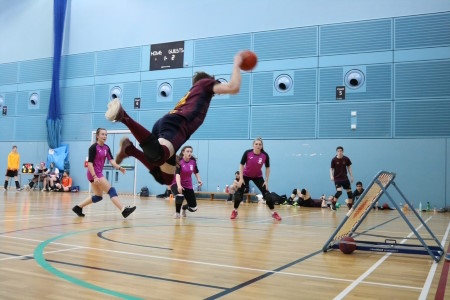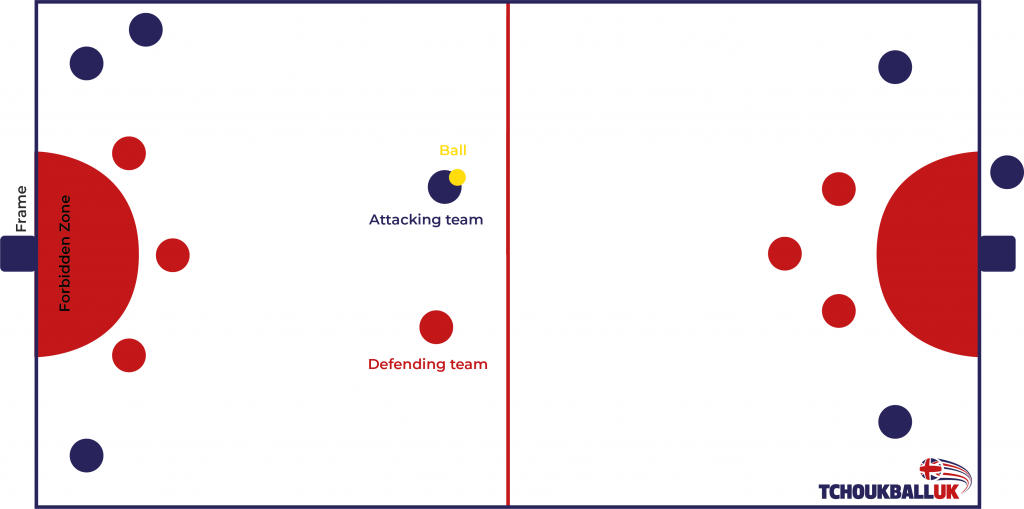Tchoukball is a team sport invented in the 1960s taking inspiration from handball, volleyball and Basque pelota. It was created by Dr Hermann Brandt, a Swiss biologist, who wanted a way of playing high-velocity sport whilst avoiding direct contact between players and thus reducing injuries. In the UK it’s mainly played indoors as a 7-a-side game and we’ll be using this format as our basis for our how to play guide. We have also included a few variations for educational/learning settings at the bottom of the page.
Tchoukball is a mixed-gender, non-contact sport. There is no tackling, blocking or obstruction of players and no interceptions of passes allowed, which means that players of different height and build can play together without impacting their game. The main skills needed to play tchoukball is the ability to catch and throw the ball, it is therefore great for hand-eye coordination and development of transferable skills. Playing tchoukball regularly will also lead to greater agility, speed, strength and reaction times.
FUN FACT: The name of the sport comes from the sound of the ball hitting the net of a tchoukball frame /’tʃuːk/.
THE BASICS
To play a game of tchoukball you need two tchoukball frames, one tchoukball, a court (ideally measuring 26-29m x 15-17m) and 2 x 3-meter D’s drawn up at each baseline (see our court illustration further down). There are 7 players on on each team and the attacking team (with possession of the ball) aims to score a point by shooting the ball at the net of the tchoukball frame so that it rebounds outside the ‘D’ and touches the ground within the court perimeter. The defending team’s role is to prevent it from touching the ground by catching it.

There are three main positions on a tchoukball team: Shooters (2 left and 2 right), defenders (2) and a centre (3-1-3 formation). Shooters specialise in scoring points, defenders are there to stop points being scored and centres distribute the ball around the court. For more advanced teams the centre position is usually omitted for a 3-4 formation where defenders from each end act as ball distributors.
While formations of players are fixed the responsibility of each player is not – shooters must also be able to defend and defenders take part in attacking plays. When teams are defending, all players are responsible for making sure the ball does not hit the ground after a shot is taken. In the image above you can see an attacking player jumping at the frame ready to shoot. The opposition, which includes the right shooter, defender and left shooter, are ready to catch the ball in defence around the ‘D’.
Something that makes tchoukball unique is that players can score at either end so there is no fixed attacking side, it all comes down to ball distribution during attacking play.

Let’s use the illustration above to demonstrate a point in tchoukball:
The blue player behind the frame on the right starts play. They pass to the centre (currently with the ball). The centre can choose to pass back to the end the ball came from or to a shooter on their side of the court. The player who receives the ball jumps from outside the forbidden zone (commonly referred to as the ‘D’) and throws the ball at the net of the frame. The ball rebounds off the frame and the red team fails to catch it before it hits the floor (outside of the ‘D’ and inside the court). That’s it! The point is scored and the red team restart from behind the frame at the end the point was scored.
If the red team had caught the shot they would have control of the ball and could shoot back at the end they caught it, or pass the ball to the other end where a red shooter would attempt to score. Play continues until a point is scored or a fault is made.
Below are some of the key rules of tchoukball – you can find more in Rules of the Game:
- The ball can’t touch anyone below the knee.
- The ball can’t touch the ground during play.
- You have 3 steps with the ball (if they catch it in the air, or 2 steps if they’re on the ground at the time).
- You have 3 seconds with the ball before you have to pass or shoot.
- The team has 3 passes with the ball before they have to shoot.
- The first pass from behind the frame is called a 0 pass and doesn’t count towards the 3.
- Both teams can shoot 3 times at the same frame before the ball has to be shot at the other end.
- You can’t enter the ‘D’ with the ball. If you’re shooting then you can jump inside the ‘D’ but you must shoot before you land.
If a fault happens then a “breakdown” is awarded to the opposing team. They gain possession of the ball and a player restarts the game by touching the ball to the floor with both hands where the fault happened on court. Once a breakdown is taken the player has three seconds before they have to pass to a teammate.
A (senior) tchoukball game is 45 minutes in total, split into 3 x 15-minute periods with 3 minute breaks.
Tchoukball variations suited for educational settings
Tchoukball can be adapted to suit your players and facilities. For junior teams the tchoukball court is normally reduced in size and the ball size varies for age categories (see our equipment page for more information). If you are training juniors, in educational settings or other, you could also add more players and keep formations more fluid or add additional passes, etc. until they are more confident with the game. Up until 2009, tchoukball was a 9-a-side game with a 4-1-4 formation. If you have more than 14 players, you could have larger teams or regularly substitute players in after any point is scored.
We would also recommend taking the frames outside when the weather allows. In many countries tchoukball is primarily played outdoors, with grass and astro turf surfaces being the best option when kneepads are worn.
Official FITB variations
- Beach (5-a-side) – open tournaments take place in Europe yearly, both senior and junior categories.
- Wheelchair tchoukball – get in touch if you are interested in setting up a team!
Have more questions? Have a browse in our Play the Game section to find out more and don’t hesitate to Contact Us if you need more information. Don’t forget to check out our Level 1 Coaching Course to get the basics down before you get started playing and coaching.
